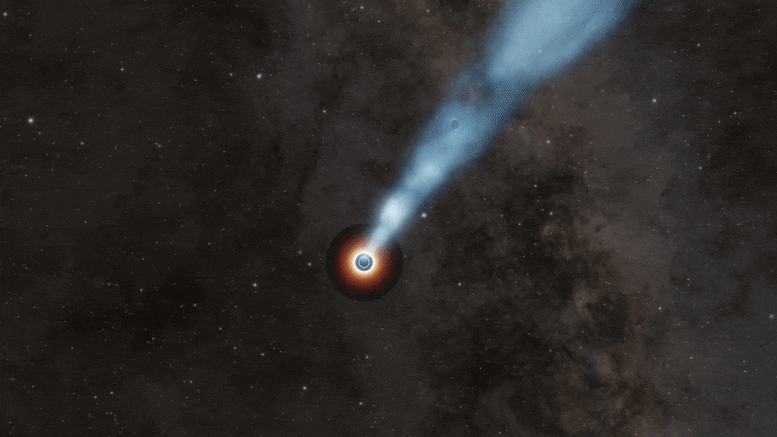Two supermassive black holes orbit one another in a binary system. They are 10 times closer to each other than the black holes in the only other known supermassive binary black hole system. Credit: Caltech/R. Hurt (IPAC)
A team of researchers from Purdue University and other institutions has discovered a supermassive
The close separation is significant because such systems are expected to merge eventually. That event will release a massive amount of energy in the form of gravitational waves, causing ripples in space in every direction (and oscillations in matter) as the waves pass through.
Finding systems like this is also important for understanding the processes by which galaxies formed and how they ended up with massive black holes at their centers.
Brief summary of methods
Researchers serendipitously discovered the system when they noticed a repeating sinusoidal pattern in its radio brightness emission variations over time, based on data taken after 2008. A subsequent search of historical data revealed that the system also was varying in the same manner in the late 1970s to early 1980s. That type of variation is exactly what researchers would expect if the jetted emission from one black hole is affected by the Doppler effect due to its orbital motion as it swings around the other black hole. Matthew Lister in the College of Science at Purdue University and his team imaged the system from 2002 to 2012, but the team’s radio telescope lacks the resolution to resolve the individual black holes at such a large distance. His imaging data supports the binary black hole scenario and also provides the orientation angle of the jetted outflow, which is a critical component in the paper’s model for the Doppler-induced variations.

Two supermassive black holes are seen orbiting each other in this artist’s loopable animation. The more massive black hole, which is hundreds of millions times the mass of our sun, is shooting out a jet that changes in its apparent brightness as the duo circles each other. Astronomers found evidence for this scenario in a quasar called PKS 2131-021 after analyzing 45-years-worth of radio observations that show the system periodically dimming and brightening. The observed cyclical pattern is thought to be caused by the orbital motion of the jet. Credit: Caltech/R. Hurt (IPAC)
Purdue professor’s expertise
Matthew Lister, professor of physics and astronomy, Purdue University College of Science, specializes his research in the following areas: active galactic nuclei, astrophysical jets and shocks, quasars and BL Lacertae objects, narrow-line Seyfert I galaxies, very long baseline interferometry.
For more on this study:
Reference: “The Unanticipated Phenomenology of the Blazar PKS 2131–021: A Unique Supermassive Black Hole Binary Candidate” by S. O’Neill, S. Kiehlmann, A. C. S. Readhead, M. F. Aller, R. D. Blandford, I. Liodakis, M. L. Lister, P. Mróz, C. P. O’Dea, T. J. Pearson, V. Ravi, M. Vallisneri, K. A. Cleary, M. J. Graham, K. J. B. Grainge, M. W. Hodges, T. Hovatta, A. Lähteenmäki, J. W. Lamb, T. J. W. Lazio, W. Max-Moerbeck, V. Pavlidou, T. A. Prince, R. A. Reeves, M. Tornikoski, P. Vergara de la Parra and J. A. Zensus, 23 February 2022, The Astrophysical Journal Letters.
DOI: 10.3847/2041-8213/ac504b
Funding: Support for the MOJAVE program includes